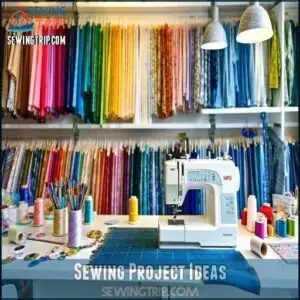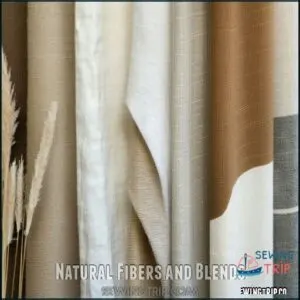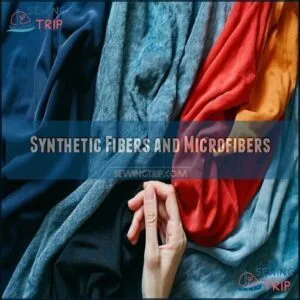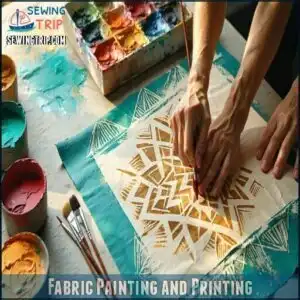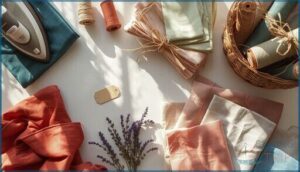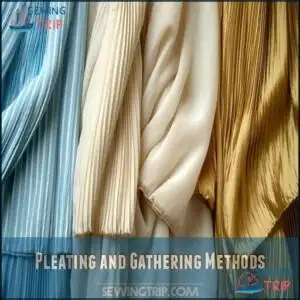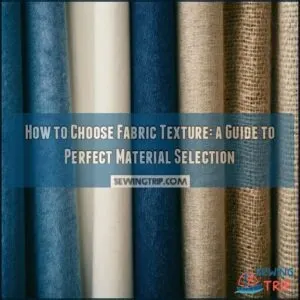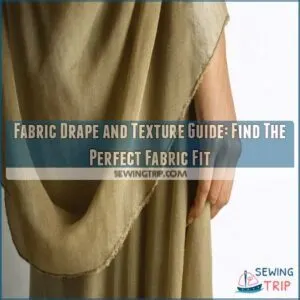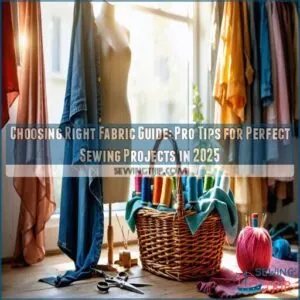This site is supported by our readers. We may earn a commission, at no cost to you, if you purchase through links.
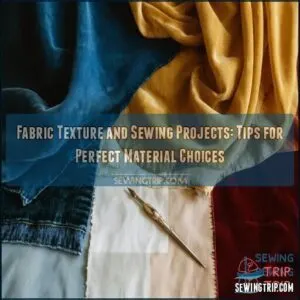
Lighter fabrics like cotton or linen work great for breezy blouses or summer scarves, while heavier textures such as denim or canvas are ideal for sturdy totes or jackets.
Pay attention to weight and drape; a soft, flowing fabric like chiffon creates elegant dresses, but it’s not great for structured items.
Experiment with textures like velvet, which adds luxury, or quilting cotton, a classic for cozy projects.
Want to up your game? Play with mixed fabrics or special embellishments!
Table Of Contents
Key Takeaways
- Choose fabric based on its weight, drape, and durability to match your project’s purpose.
- Prewash fabrics to prevent shrinkage and ensure your final piece maintains its shape and size.
- Experiment with embellishments, pleats, and textures like velvet or chiffon to elevate your designs.
- Store fabric in breathable containers and away from sunlight to avoid damage and maintain quality.
Fabric Selection Basics
Picking the right fabric for your project can feel like matching socks in the dark—tricky but essential.
Choosing fabric is like unlocking the perfect recipe—it’s all about the right mix for magic.
You’ll want to think about the type, weight, and drape of the fabric to make sure your creation looks and works just right.
Choosing Fabric Type
Picking the right fabric type starts with fiber content and weave structure.
Cotton’s breathable for summer, while wool’s cozy in winter—think seasonal fabrics.
Consider fabric durability and texture for long-lasting projects.
Smooth fabrics like chiffon flow beautifully, but crisp ones like canvas hold shape better.
Match fabric properties to your project; soft linen for dresses, sturdy denim for bags.
Considering Fabric Weight
Fabric weight sounds tricky, but it’s just how heavy fabric is per square meter (GSM Explained).
Think project suitability—lightweight fabric for dresses floats beautifully, while heavyweight fabric stays structured for jackets.
A solid fabric weight guide saves you headaches.
Remember, washing impact matters too. Shrinkage can mess with drape correlation and fabric texture, so prewash everything!
Understanding Fabric Drape
How fabric drape changes everything! It’s about how material flows and feels against the body, shaping a design’s mood.
Fabric drape defines the vibe—flowy elegance or structured precision, it shapes everything from mood to movement in your design.
Softer drapes work wonders for fluid designs, while stiffer fabrics bring structure and polish. Understanding fabric grain is essential for achieving the desired drape.
Here’s how to match drape and design:
- Rayon for flowy dresses.
- Chiffon for light blouses.
- Linen for casual fits.
- Canvas adds shape!
For more information on fabric grain, visit Understanding fabric grain. This will help you make informed decisions about fabric drape and how it impacts your design, ultimately leading to a better design’s mood.
Sewing Project Ideas
You’ve got endless options in the area of sewing projects, from stylish clothing to cozy home decor.
Pick a fabric that matches your project’s purpose, and you’ll be stitching up magic in no time!
Clothing and Accessories
When sewing dresses or clothes, think about drape vs structure.
Flowing designs? Go for soft fabrics like rayon or chiffon.
Need sturdiness? Use cotton twill or denim.
Bold print trends can make even simple cuts pop, while sustainable fabrics like organic cotton bring eco-friendly charm.
Selecting the right material involves consulting a dressmaking fabric guide.
Always consider fabric feel and fiber composition to match your fashion design dreams perfectly!
Home Decor and Furnishings
Want to spice up your home? Fabrics can do wonders! From lightweight curtain fabrics to cozy upholstery choices, there’s plenty to explore.
Think about fabric texture and feel—your throw pillows, sofa covers, or even textile art should invite comfort and style.
- Opt for soft upholstery fabric for throw pillows.
- Try sustainable decor with natural home textiles.
- Add decor accents like bold fabric runners.
Quilting and Patchwork
A cozy quilt starts with the right fabric for quilts and balanced color palettes.
Use fabric scraps creatively for patchwork or classic quilt patterns like log cabins.
Block construction gets easier with a fabric texture guide, ensuring neat stitches.
Don’t forget batting choice—it’s the secret sauce for snug, warm quilts.
Potholders are beginner-friendly and a satisfying project.
Patchwork transforms leftovers into art!
Fabric Texture Options
When you’re picking fabric textures, think about how they’ll feel and behave in your project.
A soft cotton might be cozy for a blanket, but it won’t have the structure you need for a sturdy tote bag.
Natural Fibers and Blends
Natural fibers like cotton and linen provide unmatched breathability and softness, making them perfect for clothing and home projects.
Fabric blends, combining natural fibers with synthetics, enhance durability and stretch, ideal for versatility.
Sustainable sourcing adds eco-friendly appeal, while texture variation brings creativity to life.
For example, consider organic cotton options for environmental benefits. Embrace blending benefits for balanced fiber properties and project suitability without sacrificing fabric texture or comfort.
Synthetic Fibers and Microfibers
Synthetic fibers offer strength and versatility, with polyester durability making it a go-to for performance fabrics.
Microfiber textures feel sleek but release tiny particles into water—something to keep an eye on.
Fiber composition in synthetic blends combines comfort and toughness.
For eco-savvy projects, look for sustainable synthetics. Bonus tip: pre-washing cuts down on pesky microfibers in your wash.
Fabric Painting and Printing
Fabric painting and printing let you add a personal touch to projects.
From stencils to stamps, printing on fabric creates bold designs, while painting offers unique texture effects.
Use dye alternatives for softer hues or try design transfers for precision.
For paint durability, heat-set your work.
To get started, you may need to find specialized painting tools.
These fabric texture techniques guarantee creative, lasting results. It’s fun—almost therapeutic, really!
Fabric Care and Maintenance
Taking care of your fabric might feel like a chore, but it’s the key to keeping your projects looking amazing.
Follow these simple tips, and you’ll avoid laundry mishaps, wrinkles, and shrinking disasters.
Washing and Drying Instructions
Before sewing, always pre-wash fabrics.
Follow fabric care instructions: use gentle detergent selection and stain removal techniques for delicate fibers.
Stick to low drying temperatures or opt for air drying methods to prevent damage.
Washing techniques matter—cotton shrinks, wool hates hot water, and synthetics might pill.
Proper fabric care keeps your materials looking fresh and ready, and proper care is essential for maintaining their quality, which is why delicate fibers require special attention.
Ironing and Steaming Techniques
Before ironing, check fabric care instructions to avoid damage.
Use the right temperatures—low for delicate fabrics, high for sturdy ones.
Steaming delicate fabrics works wonders for wrinkles.
Press seams with care, lifting the iron instead of sliding it.
Prevent shine by placing a cloth between the fabric and iron.
For air-drying wrinkles, use steam as a quick fix!
To guarantee longevity, clean the soleplate regularly.
Preventing Shrinkage and Wrinkles
In the context of shrinkage and wrinkles, a little prep goes a long way.
Pre-washing fabrics based on their fiber content prevents surprises mid-project.
Follow care instructions carefully, then rely on ironing techniques or steaming benefits for smooth textures.
Wrinkle release sprays can be handy too. Proper fabric care keeps sewing projects looking polished and professional—a stitch in time saves nine!
Advanced Sewing Techniques
You’re ready to elevate your sewing game with techniques that make fabric shine, from pleats to smocking.
These methods may sound fancy, but with a little practice, you’ll be creating projects that look straight out of a designer’s workshop.
Embellishments and Appliqué
Spicing up your sewing projects is easier than you think! Try these embellishments:
- Appliqué Techniques: Add bold designs by stitching fabric on fabric. Think Broderie Perse!
- Patchwork Patterns: Mix colors for new textures.
- Gota Patti Magic: Metallic shine for festive vibes.
- Reverse Appliqué: Peek-a-boo designs reveal layered creativity—perfect for vibrant fabric textures!
Many sewers find inspiration in unique fabric appliqués for their projects.
Pleating and Gathering Methods
Adding fabric pleats or gathers transforms flat materials into dimensional magic.
Use pleating styles like box, knife, or accordion to control fullness, while a gathering foot simplifies tighter ruffles. Adjust gathering density for drama or subtlety.
| Technique | Tool Needed | Result | Difficulty | Best For |
|---|---|---|---|---|
| Box Pleats | Iron, pins | Crisp folds | Moderate | Skirts, curtains |
| Knife Pleats | Pleating board | Overlapping lines | Advanced | Dresses, kilts |
| Gathering | Gathering foot | Soft puckers | Easy | Table skirts, sleeves |
| Accordion Pleats | Pleating tool | Evenly spaced folds | Hard | Formalwear |
| Shirring Elasticity | Elastic thread | Stretchy gathers | Moderate | Casual tops, dresses |
Pleating styles reveal potential, making fabric texture a star of your projects!
Smocking and Ruching Techniques
If you thought gathering was neat, you’ll love smocking and ruching.
Smocking, like a honeycomb smocking pattern or cable stitch, adds stretch and fancy flair with hand embroidery.
Ruching, including wave ruching, folds fabric into textured brilliance.
Shirred panels also bring dimensional texture.
These fabric manipulation tricks turn plain fabric into standout embellishments without breaking a sweat—or your thread!
Frequently Asked Questions (FAQs)
What can I make with fabric and sewing machine?
Think of fabric as a blank canvas—you can sew dresses, tote bags, quilts, or curtains.
Add flair with patchwork placemats or fabric headbands.
Start simple, like scrunchies, and let your creativity stitch brilliance!
What sewing projects sell best at craft fairs?
Practical items like tote bags, zipper pouches, scrunchies, and baby blankets sell like hotcakes at craft fairs.
Add unique touches—bold fabrics, embroidery, or fun patterns—and you’ll have buyers lining up at your booth!
What is the hardest clothing to sew?
Suits, lingerie, and wedding dresses are tough to sew.
They demand precision, advanced skills, and patience for fitting, intricate details, and delicate fabrics.
It’s like solving a tricky puzzle—one wrong move and it unravels!
How do I choose fabric for a sewing project?
Pick fabric based on your project’s purpose, drape, and weight.
Match flowy fabrics like rayon for dresses, sturdy ones like canvas for totes.
Don’t forget care instructions—pre-shrinking avoids surprises! It’s all about the details.
How to store fabric without causing damage?
Storing fabric is like keeping treasures safe—fold it neatly, avoid direct sunlight, and use breathable containers.
Prevent creases with acid-free tissue paper, and toss in cedar blocks to keep moths away.
What tools are essential for cutting fabric?
You’ll need sharp fabric scissors, pinking shears for fraying edges, a rotary cutter for precise cuts, a self-healing cutting mat, and fabric weights or pins.
A little patience doesn’t hurt either!
How to identify fabric grain and bias?
Did you know fabric’s grain affects how it behaves?
To find it, stretch the fabric—threads run parallel (grain) or diagonal (bias).
The bias gives stretch, perfect for curves, but don’t overdo it with the bias.
What are eco-friendly methods to dye fabric?
Try natural methods like dyeing with onion skins for yellows, avocado pits for pinks, or black tea for warm browns.
Use vinegar or salt to set the color—easy, eco-friendly, and surprisingly fun!
How to fix fabric tears or holes?
A tear in fabric is like life’s little hiccup—patch it up with fabric glue, iron-on patches, or a needle and thread.
Reinforce the area for durability, and don’t stress—it’s fixable!
Conclusion
Did you know about 90% of sewing success depends on fabric choice?
Picking the right fabric texture and sewing projects go hand in hand. Always match the fabric’s weight and drape to your project’s purpose—chiffon flows beautifully for dresses, while denim stands up for strong bags.
Don’t shy away from fun textures like velvet for luxury or quilting cotton for comfort. Take care of your fabrics, experiment, and enjoy the process.
Happy sewing—you’ve got this!


